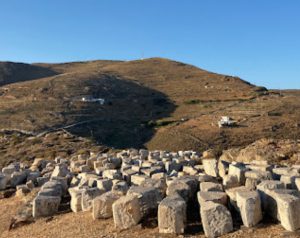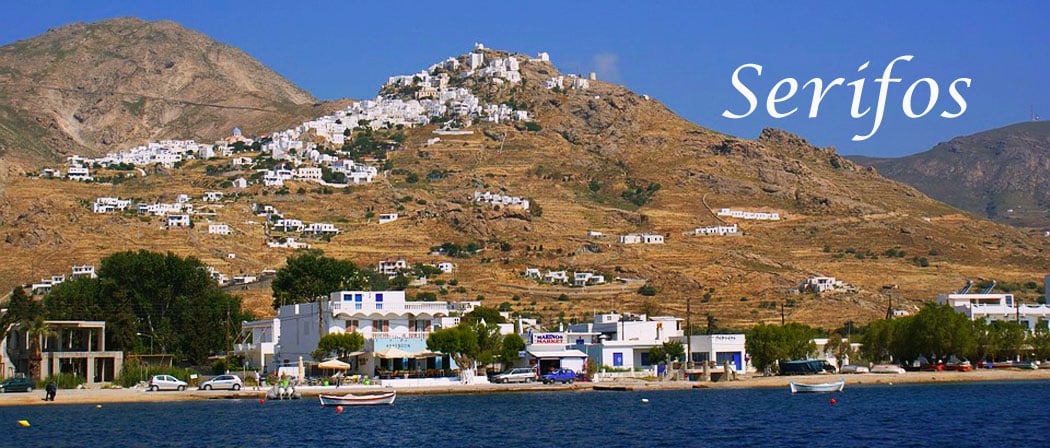History of Serifos

Significant findings from this era include the Psaropyrgos (also known as the Cyclops’s couch) southwest of Mega Livadi and another circular tower at Kefala, possibly part of a broader communication system of watchtowers in the Aegean, mentioned by Homer in his epic poems. Additionally, the Aspropyrgos, an Hellenistic-era tower serving as an observatory, is located in the bay of Koutalas. The island’s abundant and naturally filtered drinking water sources facilitated the establishment of settlements and the flourishing of the economy. One of the most important Early Cycladic settlements was situated at Plakalona near Mega Livadi.
Regarding religion, there is no archaeological evidence indicating specific deities worshiped by ancient Serifians. However, there is evidence of reverence for Perseus, as depicted on coins dating back to the 6th century BCE. Serifos was economically prosperous, as evidenced by its ability to mint competitive coins. The island was an ally of Athens, participating in the Battle of Salamis in 480 BCE with its own trireme. It later became a member of the First Athenian League until the Athenians’ defeat in the Peloponnesian War in 404 BCE. In 377 BCE, Serifos joined the Second Athenian League, and in 363 BCE, it was first occupied by the Macedonians. Later, Serifos indirectly participated in Alexander the Great’s campaign against the Persians, supplying the metal for his and his allies’ swords.
In 306 BCE, the Ptolemies of Egypt conquered Serifos, only to be retaken by the Macedonians in 266 BCE. In 146 BCE, Serifos, along with the rest of Greece, fell to the Romans. Unfortunately, due to its alliance with Mithridates VI during the Roman times, the Romans completely destroyed Serifos in 88 BCE. This marked the beginning of a long period of decline for the Iron Island, which became a place of exile. In this decline, constant pirate raids exacerbated the situation, as they pillaged the coasts and the inland areas. During Roman times, the island served as a place of exile. There are no written historical sources during the early Christian and Byzantine periods to inform us about the island’s events.
Medieval times
During the medieval times, a monastery of the cross-in-square architectural style was erected at the present location of Panagia. Later, one of the small waves of settlers who established near the monastery founded the settlement of Panagia. The temple, still standing today, is the oldest on the island. After the first fall of Constantinople to the Crusaders in 1204 CE, a new period of cultural and economic prosperity began. Under the rule of the Venetian lord Ermolao Minotto, the island’s mines resumed operations after a thousand years. In 1207, the island was annexed to the Duchy of the Aegean under Marco Sanudo, with half of it being granted to the Gizi family’s administration (1207-1334 CE).
Subsequently, Serifos became the “Apple of Discord” among various families (Vragadonoi, Minottoi, Adoldoi, Micheloi or Pikeloi, Justinianoi or Justinianoi) until the devastating raid of Khayr al-Din Barbarossa in 1537 CE. To counter these raids, the Venetians, with the help of Serifians, built the Venetian Castle in Chora, the island’s current capital, remnants of which still exist today. In 1566 CE, Serifos was conquered by the Ottomans and later administratively granted to the Jew Joseph Nasi, remaining under Ottoman rule until the Greek Revolution of 1821 CE, with the exception of the period from 1770 to 1774 CE, when it was captured by Tsarist Russia, only to be reoccupied by the Ottomans after the signing of the Treaty of Kuchuk-Kainarji in 1774 CE. In 1572 CE, the Holy Monastery of Taxiarhes was built, serving both as a monastery and fortress (monastic castle) between the present-day settlements of Platys Gialos and Galani, when the icon of Taxiarhes arrived from Cyprus. High walls, 10 meters tall, with battlements surround it, and within the walls are the church and the monks’ cells.
In the past, Serifos was particularly wealthy, possessing treasures and extensive immovable property on both the island and neighboring islets, such as Serifopoula. For this reason, it became a target for pirates. The monastery operated a mutual teaching school, where an island resident could acquire at least basic education. For many years until the establishment of the new Greek state, it served as the intellectual, administrative, and economic center of the island. During the Greek Revolution of 1821 CE, many Serifians participated in battles against the Ottomans.
Modern Times
In 1830 CE, Serifos once again became part of Greece, like the other islands in the Cyclades. However, the island was in economic decline, and after 1830, its inhabitants began to migrate to Egypt and other regions of the Ottoman Empire. For this reason, it was decided to reopen the mines, which had remained dormant for many centuries. The “Hellenic Mining Company” took on this task in 1870 after securing the exclusive right from the newly established Greek state to extract iron and copper from the subsoil. The metals were exported raw to various European countries, but after a decade, specifically in 1880, the company “Serifos-Spilialiessa” took control of the exclusive exploitation of the island’s deposits.
This company was founded by wealthy Constantinopolitans with the assistance of the Ottoman Bank and had English, French, and Ottoman interests. The German geologist Emile Grohmann undertook the extraction as a contractor through this company, and the company’s offices were housed in a neoclassical building, still standing today in Megalo Livadi Beach, albeit somewhat worn. Many times, small landowners were deceived by the company due to their low educational level, thinking they were leasing their land when, in fact, they were signing away ownership rights. Many landowners, if they resisted, usually succumbed to the pressure exerted by the socio-economic establishment dependent on the company. In 1882 CE, “Serifos-Spilialiessa” faced an economic crisis, impacting the workers’ wages and leading to minor disturbances, but it was soon overcome.
